- Ask a related questionWhat is a related question?A related question is a question created from another question. When the related question is created, it will be automatically linked to the original question.
This thread has been locked.
If you have a related question, please click the "Ask a related question" button in the top right corner. The newly created question will be automatically linked to this question.
Tool/software:
Hi Team,
Can you please help us with our customer inquiry below.
We are trying to enable CLK_IN_0 (image 1) to have a 10MHz signal sync with the device. Looking at TICS and PYNQ forums
https://discuss.pynq.io/t/xrfclk-configuration-lmk04828-using-external-10mhz-reference-clock/5562/12
https://e2e.ti.com/support/clock-timing-group/clock-and-timing/f/clock-timing-forum/1229913/lmk04828-taking-driving_clock-from-another-input-pin-and-i-can-t-figure-out-which-one/4661353#4661353
I came across 3 different solutions. Provided are .txt files for hex import for each. Using TICS PRO, I am trying to configure our board to have a 10MHz external clock control while disabling OSCin internal referance clock. The other frequencies on the image should remain the same. I don't want to program the board by using USB2ANY cable with any of these .txt files for hex import because we don't have the default LMK04828 .tcs file for the RFSoC4x2. Can you please help us on how we can proceed? We are really stuck and Real Digital didn't provide us the default LMK04828 file for the board.
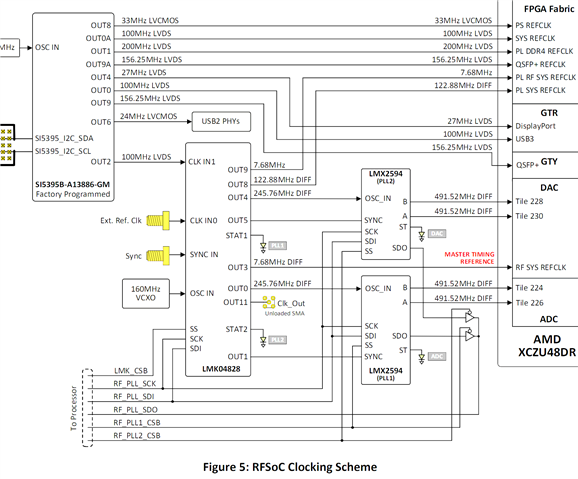
Regards,
Danilo
Let me try to understand this:
1. You are using a 3rd party board that has the LMK04828
2. You are not sure what the settings are for this board for the LMK04828
3. If you knew the settings for the LMK04828, then you could use TICSPRO, but provider of the board (Real Digital), is not giving you this information.
With TICSPRO, you can export and import hex registers to other tools and this does not require you to have TICSPRO hooked up to the board. If TICSPRO is hooked up to the board, you can also read back the register states.
Or if you are asking for a configuration file based on the frequencies in the above diagram, we can provide that. However, to do this we need:
With your frequencies, I think you want the VCO to be 2949.12. You could use the 160 MHz OSCin value, but this will lead to a very low phase detector frequency, which will work, but yield not very good perforamnce. It would perform much better with a differetn OSCin frequency like 122.88, but this is a hardware change.
Regards,
Dean
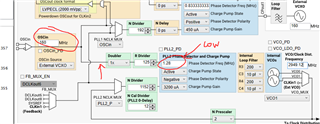
Regards,
Dean
Hi Dean,
Please see our customer's response below.
We connected USB2ANY to the board and read the register values however, they didn't match with what they have on Figure 5. We think that is possible since USB2ANY doesn't connect directly to LMK but instead to Skyworks Si5395.
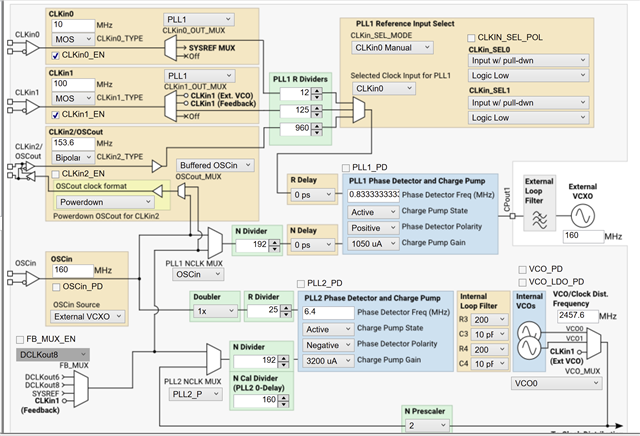
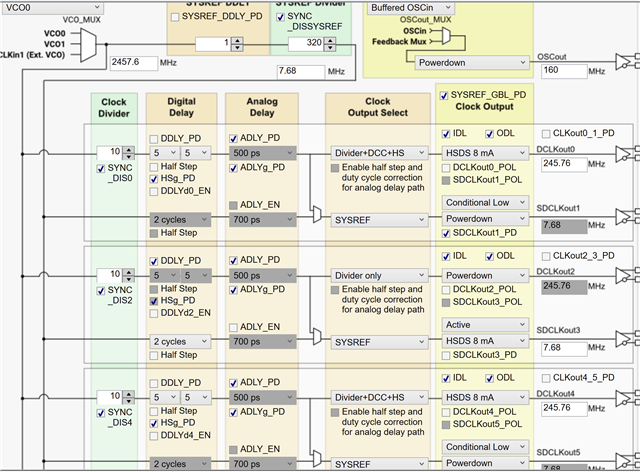
Hi Danilo,
first of all, although the board was not design by our customer, I have doubt to the block diagram.
7.68MHz clocks have to be generated by the SYSREF block of LMK04828, as the clock divider is not big enough to support 7.68MHz. This is fine as long as the SYSREF block is configured as Continuous SYSREF output.
OUT4 and OUT1 are used as the SYNC signal to LMX2594, SYNC signal is a single pulse so it also have to be generated by the SYSREF block of LMK04828. However, in this case, the SYSREF block needs to be configured as Pulser mode.
That means, OUT3 and OUT9 will be a pulse instead of continuous clock when we attempt to synchronize the LMX2594 devices.
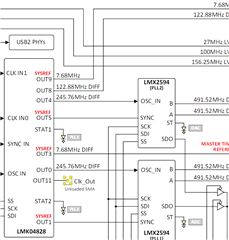
Back to the LMK04828 configuration, here is the configuration.
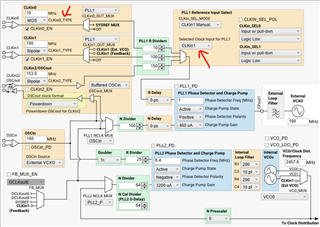
The 10MHz clock needs to be square wave, otherwise PLL1 may not lock. Use a square wave clock and set the input type to MOS.
Use the register next to PLL1 R Dividers to select CLKin1 or CLKin0.
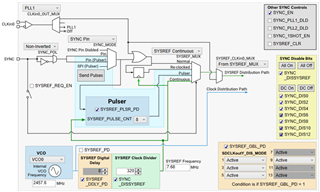
Configure SYSREF to Continuous clock mode.
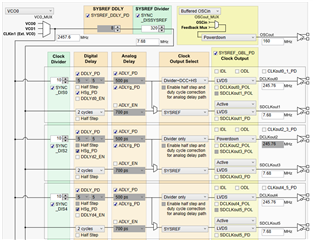
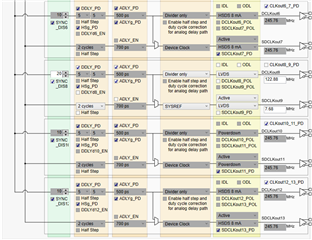
example output configuration, you may need to select the correct output format based on the board design.
here is the tcs file.
Hi Danilo,
To add to what Noel said, in order to achieve phase synchronization between the input and output signals, you will have to put the device into zero-delay mode. I have attached a tcs file that does that, you will just need to update all of the outputs as you see fit. However, the phase noise performance will be suboptimal due to the numbers that the configuration will have to support - as Dean mentioned, it would be better if the VCXO frequency were 122.88 MHz.
Furthermore, in order to achieve the deterministic phase relationship between the input and output, you will need to generate a SYNC event. Section 9.7.3.10 provides an overview of how to generate one. The SYNC event results in all of the output dividers being phase aligned, and you will have achieved your necessary clock tree and input output relationships.
Thanks,
Michael
Hi Noel and Michael,
Thank you for your help. We have 3 more questions regarding this. I modified the zero-delay rfsoc file to match with our required clock output values and also enabled continuous SYNC for deterministic phase relationship. Here is how it looks right now.



We have a few more questions.
1- The first .tcs file you provided has a different internal VCO clock compared to the zerodelay .tcs file. (2457MHz / 2949MHz). As long as the output clocks have the right frequency, does the internal VCO clock's frequency matter?
2- I modified SYNC/SYSREF to be in continuous SYSREF mode referencing from the section you mentioned, I think this mode should continuously align the phases. Also, the selected clock input for PLL1 should be CLK0 since that's where the signal generator's 10MHz will be connected. Are these right assumptions?
3- PLL1 and PLL2 are both locked in this configuration. Before continuing to test this .tcs file with our RFSoC4x2 board and signal generator. Is it possible for you to check/verify the accuracy? I attached .txt file for raw register values. Real Digital doesn't reply back to our emails. We want to make sure to have the correct configuration.
R0 (INIT) 0x000090 R0 0x000000 R2 0x000200 R3 0x000306 R4 0x0004D0 R5 0x00055B R6 0x000600 R12 0x000C51 R13 0x000D04 R256 0x01000C R257 0x010155 R258 0x010255 R259 0x010301 R260 0x010422 R261 0x010500 R262 0x0106F0 R263 0x010711 R264 0x01080C R265 0x010955 R266 0x010A55 R267 0x010B00 R268 0x010C22 R269 0x010D00 R270 0x010EF0 R271 0x010F10 R272 0x01100C R273 0x011155 R274 0x011255 R275 0x011300 R276 0x011422 R277 0x011500 R278 0x0116F1 R279 0x011701 R280 0x011818 R281 0x011955 R282 0x011A55 R283 0x011B00 R284 0x011C02 R285 0x011D00 R286 0x011EF1 R287 0x011F33 R288 0x012018 R289 0x012155 R290 0x012255 R291 0x012300 R292 0x012422 R293 0x012500 R294 0x0126F0 R295 0x012711 R296 0x01280C R297 0x012955 R298 0x012A55 R299 0x012B00 R300 0x012C02 R301 0x012D00 R302 0x012EF9 R303 0x012F00 R304 0x01300C R305 0x013155 R306 0x013255 R307 0x013300 R308 0x013402 R309 0x013500 R310 0x0136F9 R311 0x013733 R312 0x013820 R313 0x013903 R314 0x013A01 R315 0x013B80 R316 0x013C00 R317 0x013D08 R318 0x013E03 R319 0x013F11 R320 0x014009 R321 0x014100 R322 0x014200 R323 0x014333 R324 0x01447F R325 0x01457F R326 0x01460B R327 0x0147BA R328 0x014812 R329 0x014952 R330 0x014A02 R331 0x014B16 R332 0x014C00 R333 0x014D00 R334 0x014EC0 R335 0x014F7F R336 0x015003 R337 0x015102 R338 0x015200 R339 0x015300 R340 0x01540A R341 0x015500 R342 0x015601 R343 0x015700 R344 0x015801 R345 0x015900 R346 0x015AA0 R347 0x015BD4 R348 0x015C20 R349 0x015D00 R350 0x015E00 R351 0x015F0B R352 0x016007 R353 0x0161D0 R354 0x016284 R355 0x016300 R356 0x016424 R357 0x016500 R369 0x0171AA R370 0x017202 R380 0x017C15 R381 0x017D33 R358 0x016600 R359 0x016706 R360 0x016800 R361 0x016959 R362 0x016A20 R363 0x016B00 R364 0x016C00 R365 0x016D00 R366 0x016E13 R371 0x017300 R386 0x018200 R387 0x018300 R388 0x018400 R389 0x018500 R392 0x018800 R393 0x018900 R394 0x018A00 R395 0x018B00 R8189 0x1FFD00 R8190 0x1FFE00 R8191 0x1FFF53
Regards,
Danilo
Hi Danilo,
1. Preferably, you would use 2457.6 MHz as your VCO frequency, as this will require a lower N divider value, which will reduce the phase noise.
2. Continuous SYSREF (while the correct SYSREF configuration)will not automatically align the phases, you must perform a SYNC event to achieve that. Also, yes, you should select CLKin0 as the driver of PLL1 if that is the input for the 10 MHz signal.
3. I cannot test your exact configuration on my board, as our evaluation boards come with 122.88 MHz VCXOs attached. However, I can confirm that both of your PLLs lock. I downloaded your configuration and tested it (albeit with different numbers for the first PLL, but with numbers that have the exact relationship as in your configuration) and found that both PLLs will lock.
I have attached the final configuration for good measure. Hope this helps.
Thanks,
Michael